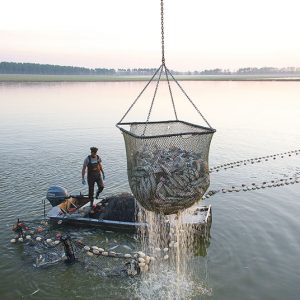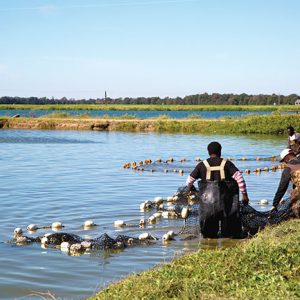
Retail sales cushion pandemic’s impact
January 20, 2021
By Julia Hollister
But labor shortage presents complications
 Jeremy Robbins, VP at The Catfish Institute, has made it his mission to make sure everyone in America has the chance to taste US farm-raised catfish
Photo: TCI
Jeremy Robbins, VP at The Catfish Institute, has made it his mission to make sure everyone in America has the chance to taste US farm-raised catfish
Photo: TCI Jeremy Robbins, vice president of the Catfish Institute, will be glad to say goodbye to 2020 and sit down to a plate of fried catfish. “With 70 percent of our sales going to restaurants, the US farm-raised catfish industry was severely impacted by the coronavirus pandemic, particularly during the first several months,” he says. ”However, some of our markets shifted toward retail as consumers stepped away from restaurant dining during the pandemic and looked for easy at-home meal ideas.”
More people from outside of Alabama, Arkansas, Louisiana and Mississippi – the largest markets and producers of US farmed catfish – are discovering catfish. Robbins has made it his mission to make sure everyone in America has the chance to taste US Farm-Raised Catfish.
Danny Walker, CEO of Heartland Catfish Company in Itta Bena, Mississippi, agrees: “People are staying at home, cooking for their families and trying new products. We’ve seen some people try catfish for the first time and who realized that it is a good, wholesome, delicious product that can be prepared in many ways.”
“We expect to still see demand growth for fresh products, especially in the retail market,” he says.
But there are some complications. Labor shortage both on the farm and in the processing plants is limiting farmers’ ability to put up frozen inventory for spring and summer, says Walker.
“Finding labor for the processing plants may be the biggest challenge in the industry right now. Feed sales indicate there will be less fish available to harvest next year. This indicates that prices for catfish will be a bit higher in 2021 than in years past. This is not an unheard-of situation, but the labor shortage does make it a bit more complicated.
“Is that related to COVID? It’s tough to say; at first we thought it was related to the extra benefits offered for unemployment but that has, for the most part, gone away. Yet the industry is still struggling to staff the plants.”
Robbins of the Catfish Institute says labor shortage is the greatest challenge American catfish farmers are facing in the long term. As rural populations continue to decline, he is seeing fewer and fewer applicants for vital roles in the industry.
For now, catfish producers are thankful that their restaurant clients have found ways to continue operating, even at reduced levels, inspite of the burden the virus has placed on them.
Revisiting an old problem
Imports of catfish-like products from Asia have, for many years, been taking away market share from US-farmed catfish. Although their flow into the US market has somewhat abated since 2017, the industry remains vigilant.
“The imports are considerably cheaper than ours due to various factors such as governmental oversight, labor costs, lack of regulations,” says Walker. “Our company and other organizations representing US farm-raised and US grown products (including The Catfish Institute) are working to consistently educate both buyers and end consumers about the difference in quality between imported and domestic catfish products.”
Robbins added: “We continue to fight for a fair and level playing field when it comes to imported catfish and catfish-like products – pangasius (sold as Bass, Swai and Tra) – from overseas, mainly China and Vietnam. We are pleased with the progress that has been made, and we are thankful for the USDA inspection, which ensures a safe product for consumers and their families.”
Edwin Caba, owner and chef at two Northern California restaurants in San Francisco and San Carlos, offers Heartland Catfish on his menu. “We have been a customer for over 24 years,” he says. “The supply has been steady and we consistently purchase 240 lbs a month.”
Caba says selling catfish to his customers is an easy job. He says most customers ask whether the catfish was farmed sustainably and how is it prepared. His CreoLa restaurant’s two locations serve catfish in cornmeal batter or blackened with remoulade sauce and as a ‘PoBoy sandwich.
Advertisement
- Mowi seeks judicial review of Discovery Islands closure
- How Digital Twin could double down farm efficiency








